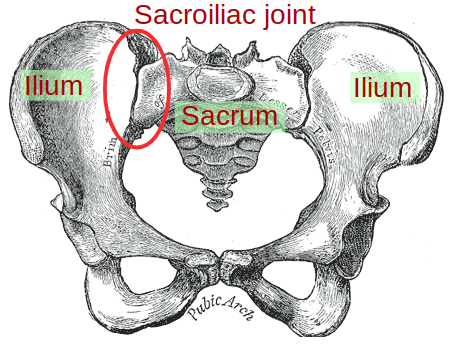Hey everyone! Some positive updates for you today.
I’ve recently started studying for the Certified Personal Trainer exam through the National Academy of Sports Medicine.
It’s something I’ve thought of doing off and on throughout the years. I decided to finally do it, so that I can help my coaching clients with more targeted exercise advice. It’s also a great recap of everything I had to learn in my physical therapy prerequisites.
And I noticed something new– for the first time, since I started considering this certification in 2014.
They actually mention the sacroiliac joint.

I have literally never seen this joint mentioned in any of their study materials before, and I’m so excited!
I’ve looked into their study materials several times throughout the years, and while I’ve seen them address things such as the knee, the rotator cuff, and even the spine, I’ve never seen this!
I think this is such a great indication that awareness is growing.
I love the National Academy of Sports Medicine, and I’ve always known that their certification is the one I wanted to do.
I think the fact that they’re now mentioning the SI joint is really a sign that more and more people are talking about the issue, going to PT and asking for help with it, and now fitness professionals are showing up in gyms talking about it.
It’s still brief– the CPT exam is meant to be generalized, and doesn’t necessarily focus in on any one joint.
However, they mention it in the context of a group of muscles called the posterior oblique sling, which are meant to stabilize it.
The posterior oblique sling
This muscle group consists of the lattismus dorsi muscle on one side of the body (commonly called the “lats”).

This muscle then connects to the sheet of connective tissue that covers our lower back, called the thoracolumbar fascia. (It’s basically the white area covering the lumbar spine and sacrum in the picture above).
From there, it connects with the gluteus maximus muscle on the opposite side, to form this sling that crosses the back of the body at a diagonal:

The posterior oblique sling works to stabilize the SI joints, by counteracting the forces that affect the joint at this angle.
The lats one one side of the body can contract, and absorb the force traveling across the thoracolumbar fascia from the gluteus maximus on the other side.
This system works along with other muscular subsystems, to form an even more complex stabilization system. (NASM gives examples of all of these subsystems, and different ways to train them, here).
I think this is just such a cool thing to know.
At the end of the day, designing the right exercise program– using targeted concepts such as these– is going to be what helps your joints stay in alignment.
In my experience, having a PT or other qualified hands-on professional properly assess your alignment, of course, is going to be a huge part of it. You really need to this piece in place, because you can’t really start an exercise program when you’re stuck out of alignment.
However, once you’ve find the right person to correct your alignment and teach you some self-adjustments, ultimately it’s going to be strengthening which keeps things in place.
When you can begin to strengthen these built-in stability systems your body already has, that’s the point when at you stop needing to constantly realign things, and can start to live more of a normal life.
So… I am so excited to see such a prestigious group as the National Academy of Sports Medicine begin to address the SI joint as an issue area.
The more and more we, as SIJD warriors ourselves, can start speaking up about it, the better things are going to get! I really think it’s a sign that things are changing!
I’m so excited to sharing more of these specific, stabilization exercise concepts up ahead — stay tuned!
This looks great! Congratulations on starting your course. I look forward to hearing more about the specific exercises and adding them to my routine. I really appreciate your efforts to present everything so clearly and provide good sources for the suggested exercises. There is so much confusing information out there about this problem which often only ends up making things worse so bravo. I am so glad to hear that the sacroiliac joint is gaining in awareness – at last!
LikeLike
Thank you so much for the kind words, Elizabeth! I’m so glad my information has been clear– it’s something I put a lot of effort into! I’ve totally been there, in terms of following the wrong information and finding it made things worse, so I try to give people a path out of that on my site.
So excited to see where the increased awareness takes us!
LikeLiked by 1 person
Omg this is awesome! I’m glad you’re pursuing NASM CPT! I actually recently got my certification (sadly I had to toughen up and deal with the pain to just take the exam). But I’m glad to know a fellow future CPT!
LikeLiked by 1 person
Wow, that’s so cool (although I’m sorry to hear about the pain during the exam!). I have so much respect for NASM and really love their whole approach. They seem to put more of an emphasis on “healing,” and have more of a holistic model, compared to some of the other certifications. Curious if you’ve noticed this too?
LikeLiked by 2 people
Great information and makes perfect sense! Love that you are pursuing this and so thankful for your input and dedication. Thanks again! Wonderful!
LikeLiked by 1 person
I’m so glad this was helpful, Michelle! Thank you so much for the kind words!
LikeLiked by 1 person